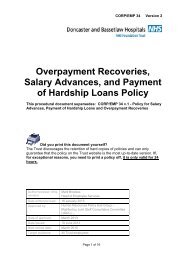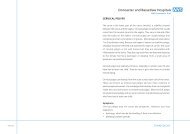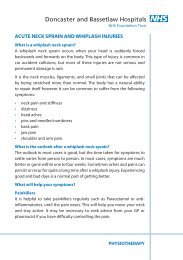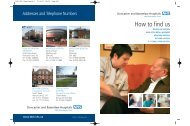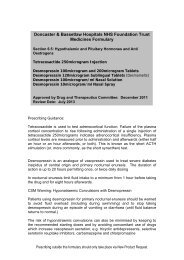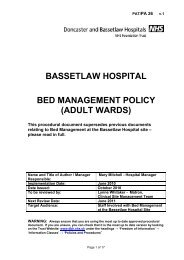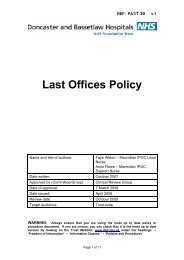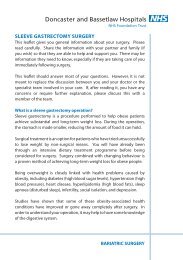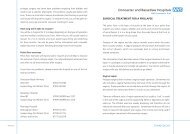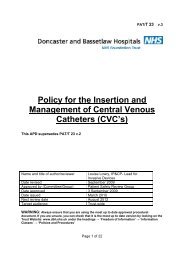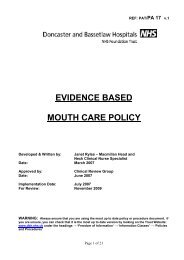VARIANT CREUTZFELDT-JAKOB DISEASE (vCJD) AND ...
VARIANT CREUTZFELDT-JAKOB DISEASE (vCJD) AND ...
VARIANT CREUTZFELDT-JAKOB DISEASE (vCJD) AND ...
Create successful ePaper yourself
Turn your PDF publications into a flip-book with our unique Google optimized e-Paper software.
PAT/IC 4 v.3<br />
Table 5. Summary of precautions advised for use of endoscopes<br />
Adapted from “Transmissible spongiform encephalopathy agents : Safe working and the prevention of<br />
infection” – Annex F. Department of Health Jan 2010<br />
Tissue infectivity<br />
High<br />
• Brain<br />
• Spinal cord<br />
Medium<br />
• Olfactory<br />
epithelium 2<br />
• Lymphoid tissue 3<br />
(<strong>vCJD</strong> only)<br />
Status of patient<br />
Symptomatic<br />
Definite/<br />
Possible/<br />
probable diagnosis unclear<br />
Single use<br />
or<br />
Quarantine 1<br />
pending diagnosis<br />
Single use<br />
or<br />
Destroy after use<br />
Single use<br />
or<br />
Destroy after use<br />
Low/none detectable<br />
• All other tissues 4 No special<br />
precautions<br />
Single use<br />
or<br />
Quarantine 1<br />
pending diagnosis<br />
No special<br />
precautions<br />
Asymptomatic<br />
At risk<br />
iatrogenic/familial<br />
Single use<br />
or<br />
Destroy after use<br />
or<br />
Quarantine for re-use<br />
exclusively on same<br />
patient<br />
Single use<br />
or<br />
Destroy after use<br />
or<br />
Quarantine for re-use<br />
exclusively on same<br />
patient<br />
No special precautions<br />
1 The endoscope should be fully cleaned and decontaminated (alone using an AER) immediately<br />
after use and quarantined as for surgical instruments (see above). Following decontamination, the<br />
quarantined endoscope may be re-used exclusively on the same individual patient if required. If<br />
further clarification of the diagnosis is not possible, the endoscope should be removed from use.<br />
2<br />
The advice of the consultant carrying out endoscopic procedure in the nasal cavity should be<br />
sought to determine whether a risk of contamination with olfactory epithelium can be excluded with<br />
confidence. If such contamination cannot be excluded, take precautions appropriate for medium<br />
infectivity tissue.<br />
3 Lymphoid tissue refers to spleen, thymus, tonsils, adenoids, lymph nodes, appendix and gastrointestinal<br />
tract sub-mucosa.<br />
4 For patients with, or at risk of, <strong>vCJD</strong>: For all other types of endoscopy, providing decontamination<br />
of the endoscope is to approved standards, the use of the instrument for inspection in the absence<br />
of invasive procedures is deemed to be a low risk procedure. If a biopsy or other invasive<br />
procedure is carried out, the possibility of contamination of the instrument channel with lymphoid<br />
tissue means the endoscope should be quarantined pending assessment of likely contact with<br />
potentially infected tissue. See “Transmissible spongiform encephalopathy agents : Safe<br />
working and the prevention of infection” – Annex F. Department of Health and “Endoscopy<br />
and individuals at risk of <strong>vCJD</strong> for public health purposes” A consensus statement from the British<br />
Society of Gastroenterology Decontamination Working Group and the ACDP TSE Working Group<br />
Endoscopy and <strong>vCJD</strong> Subgroup for further advice and details of invasive procedures.<br />
Page 19 of 22



